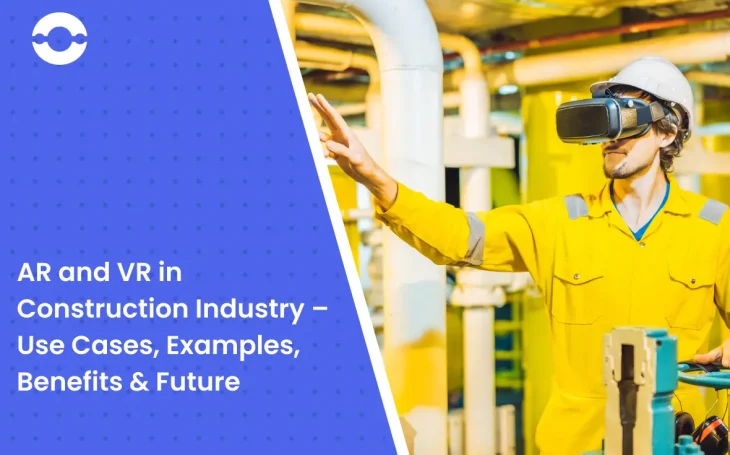
AR and VR in construction have been a boon in many ways. The industry survived and continued its operations eventually during the pandemic through the use of AR and VR. The two technologies have made a larger space for themselves in the sector post that.
In this blog, we will look at the various use cases, examples, benefits, and future of AR and VR in the construction sector in detail.
The building industry has steadily moved toward advanced technology procedures. Building on top of current technology, AR and VR are designed to provide construction teams with additional information and improve their planning.
Continue reading to find out more about how AR/VR technology may enhance workflows in the construction industry.
So, let’s begin!
AR and VR in construction industry
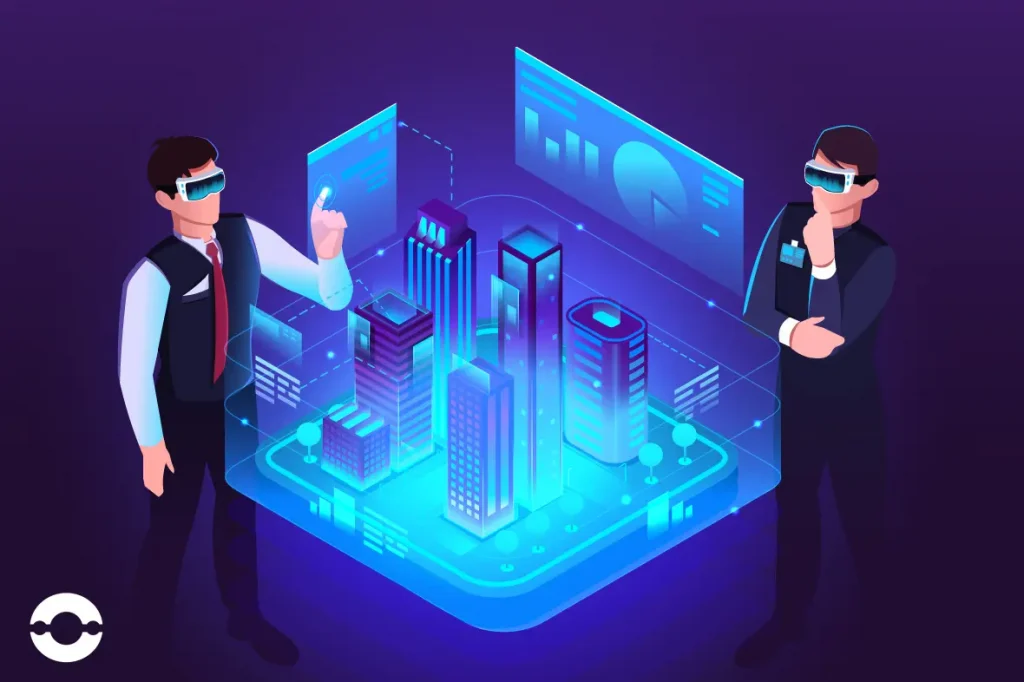
Despite the construction industry coming a long way in terms of the quality of material, equipment, and safety norms, there are still gaps that need to be filled to mitigate the danger, and inefficiency that is crippling the sector.
As a result, the field currently lacks the appeal for the new generations of potential workers. Technology could help the industry overcome these issues.
In fact, a survey of 33 top UK construction companies found that 36% of them are open to implementing the technology in their operations
Augmented reality and virtual reality are the two technologies that could extensively assist the construction industry in enhancing its workflows, fostering better coordination as well and offering effective training methods.
These emerging technologies have revolutionized multiple key industries. From the hospitality sector to gaming and entertainment to engineering and logistics, AR and VR have changed the way industries operate. Thus, the construction industry undoubtedly could benefit from them.
While VR is a digital and visual experience delivered via special headsets, AR blends the physical and digital environments into one immersive experience. Both technologies are used in construction to provide more information, better training, and planning coordination to the teams.
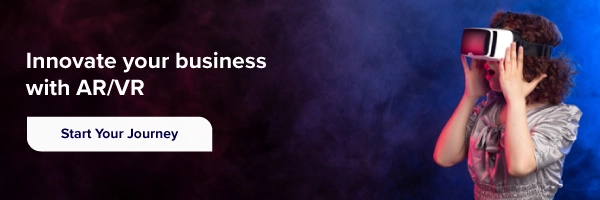
These technologies are taking the industry towards greater efficiency, and safety and hence, rapid growth. In fact, the latest AR/VR technologies are capable of reducing building costs by up to 90%.
Additionally, these technologies could save the construction industry up to $15.8 billion by preventing errors and mistakes caused by insufficient or inaccurate data.
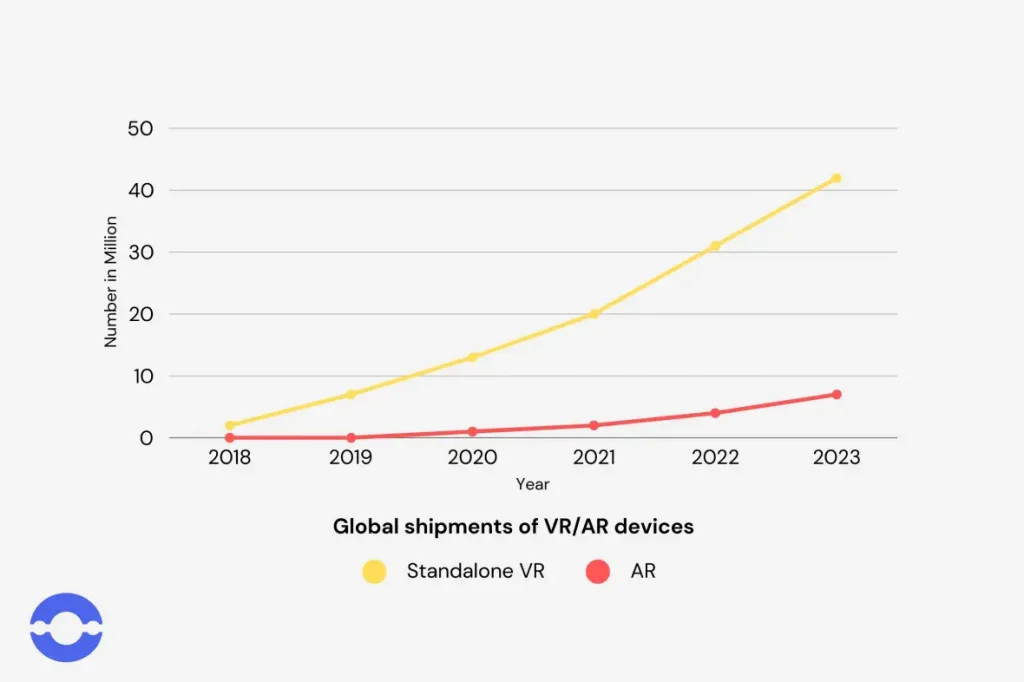
Global shipments of VR/AR devices
A study conducted back in 2019 surveyed construction practitioners with hands-on experience using AR. Respondents reported that AR enhances:
- project visualization as it facilitates a virtual walk through the project for owners and contractors,
- supports decision-making on-site by bringing office and field closer,
- allows for a better understanding of project space like exploring complex mechanical spaces, and
- promotes collaboration and knowledge sharing.
While AR/VR is being extensively used in retail, e-commerce, marketing, advertisement, etc., let’s see how it is being used in the construction industry, on and off-site.
AR and VR in the construction industry: Use Cases
The construction industry is a complex sector with major manual processes involved and lives at stake. Thus, the entire planning and execution of a project demands proper coordination, meticulousness, and accuracy.
AR/VR in the construction industry could help different departments create synergies and enhance the efficiency of work practices. Different department heads use these technologies to strengthen inter and intra-team interactions and workflows.
Let’s see the areas/processes AR/VR improve in the construction industry.
1. Project planning
The role of AR and VR in construction starts from the very early stages of project planning and preparation. Working in tandem with a 3D modelling system and Building Information Modelling (BIM), these two technologies allow construction businesses to create detailed, interactive models of building projects.
For example, Layton Construction, an American commercial contractor, invested heavily in VR and BIM. So, while building a 485,000-square-foot, 280-bed medical centre in Florence, the company leveraged VR technology instead of building 20 physical mock-ups for the owners and end users to experience, which would have cost over $250,000.
These models can then be presented to the clients for better understanding and implementation of the project. Owners can better interact and explore the design of their facility. Using the AR headsets, 3D models are even projected in a room where owners can walk around and discuss various design options.
Any changes or modifications required can be communicated before investments are made into physical construction.
In the above example, Layton ended up decreasing its mock-up construction costs by 90%. In addition, required design changes and prefabrication opportunities were identified through the feedback received from the VR experience; this ultimately improved the project’s timeline.
Similarly, Nova, a large hospital in Finland, was a project created through VR experience based on BIM. The design was shown to hospital staff, and feedback suggestions for changes were received. The staff also got an opportunity to familiarize themselves with their new workplace in advance, allowing for an easy transition.
2. Real-time project data monitoring
AR and VR in construction allow businesses to attach complete digital information about a project with its physical location and exercise better control over the project.
Users can access and visualize data such as location, styles, and building shell addition types using AR technology. From architectural elements like windows and doors to MEP components such as ducts and pipes, all these could be visualized and related data could be accessed in just a few clicks.
The on-site crew especially benefits from this feature. Combining digital information and project documentation with the physical view and dynamics is a known boon. It allows for better control over the situation.
Microsoft’s HoloLens, for example, is capable of displaying the physical dimensions of a working space. Included in the 3D models, this data can allow construction companies to visualize and construct more precisely.
Augmented reality in construction further supports monitoring and documentation of the improvements in the physical site to visualize and understand progress information.
The DAQRI Smart Helmet, for example, is a helmet that facilitates the visualization of projects and 3D models in AR. It offers an immersive and large-scale 3D environment for viewing the project. Work-in-progress to the original design could be compared by the teams, and work accuracy could thus be improved.
3. Streamlined project workflows and improved collaboration
AR and VR models in the construction industry could be easily shared across teams, irrespective of their locations; boosting project coordination and collaboration.
Stakeholders can also view these images or videos in greater detail. This allows them to identify errors or issues without having to be physically present at the construction site.
Details such as HVAC systems, pipes, windows, and doors, could be viewed by the entire team, including the remote workers. Details could be compared to those of the building plan, allowing companies to reduce the time spent on fixing both minor and major errors.
The Wild, for example, is a software platform that enables greater collaboration between team members by combining AR with VR technology. Multiple teams can get access to the virtual workspace that includes design reviews and creates markups, through this software. This also facilitates remote work.
Similarly, Akular AR is a cloud-based technology that allows users to view 3D models of the physical environment on their smart devices. It enables users to conduct walkthroughs of 3D models by just downloading the app, uploading the 3D model, and seeing it coming to life using your device.
The technology optimizes BIM models, allowing users to evaluate them on-site and share BMS and IoT sensor data, all in real time.
Furthermore, in a study carried out on AR’s use cases in the construction industry, the users of AR in the design phase stated that the technology improves project visualization, project understanding, and collaboration. In addition, it allows multiple stakeholders to be engaged in the design process.
4. Safety training
The most important use case of AR and VR in construction is safety training and improvement in the overall security of workers. In an industry like construction where manual processes are dangerous, and the margin for error is extremely low, safety must be prioritized.
With the help of an AR and VR headset, workers can access virtual drills, instruction as well and safety scenarios. These technologies facilitate virtual training sessions which allow staff to identify potential risks before the start of a project through computer prototypes. AR software also offers great location accuracy; it virtually displays exactly where an incident will occur or has already occurred.
These technologies further allow workers to interact with the machinery, equipment, and other elements common to the physical site/workplace through simulation.
This in turn allows them to form muscle and visual memory similar to one that is developed in a real-life scenario. AR training simulations allow workers to test if they know what needs to be done in dangerous situations, without putting the user in actual danger.
Although all movements cannot be fully replicated with hands, AR and VR-powered training gives a fair idea of the work required with potential perils.
Moreover, this training could be done from anywhere without the need for professional gear or heavy-duty equipment. This makes them very accessible and practical processes.
Additionally, they are direct learning styles that not only improve staff awareness of safety guidelines and protocols and provide intuitive training but also reduce training costs and downtime.
A framework for a safety management and visualization system (SMVS) was also proposed in 2013 by Park and Kim in their research paper titled ‘A framework for construction safety management and visualization system’. It integrates AR, location tracking, building information modeling (BIM), and gaming technologies to enhance construction safety management practices.
Furthermore, a VR training simulator for New York City crane operators was also developed back in 2022. The app allowed trainees to get familiarized with the heavy machines before actually working on the real ones.
Overlays and tags are also used to enhance safety at the construction sites. An overlay can be used to see the completed building in its final location but also to see specific aspects of the building plans superimposed over what is already there.
While tags are placed on hazardous instances, indicating a fix or avoidance in these “danger zones”.
5. Installation process and equipment monitoring
A construction project involves a lot of details, documentation, and continuous changes. In fact, around 30% of the work done by construction companies is rework.
To keep up with all these, construction companies are implementing model-based construction using AR technology that allows for development within shorter time frames.
AR tools further help staff spot the machines and their usage at any given point at the site. In addition, sharing equipment between divisions or departments also streamlines the use of these tools.
Furthermore, VR in construction reduces rework costs in case of changes. This is because the staff can display interior and exterior views of a structure and make modifications to the virtual plans while keeping the original view intact, using this technology.
All the changes made can be kept on record for future review as well. Similarly, structural issues can be viewed and understood, and changes can be made with a few clicks on an AR-enabled device.
Since rework is one of the main issues in the construction industry, virtual visualization, among other solutions, could significantly reduce the costs associated with client changes and errors committed by workers.
New Rochelle, a mid-sized community in New York, for example, enhanced its downtown area regeneration program using a virtual reality platform. This platform enabled users to see about 3 Mn square feet of changes and renovations in 360-degree views.
The experience was also made available to residents on headsets and mobile devices by the city planners to receive real-time and accurate feedback.
Also Read: Benefits of AR And VR In The Retail Industry
AR and VR in the construction industry: Benefits
After use cases, we will look at how the application of AR and VR in construction enhances the workflows and outcomes.
Some benefits of AR and VR in construction are:
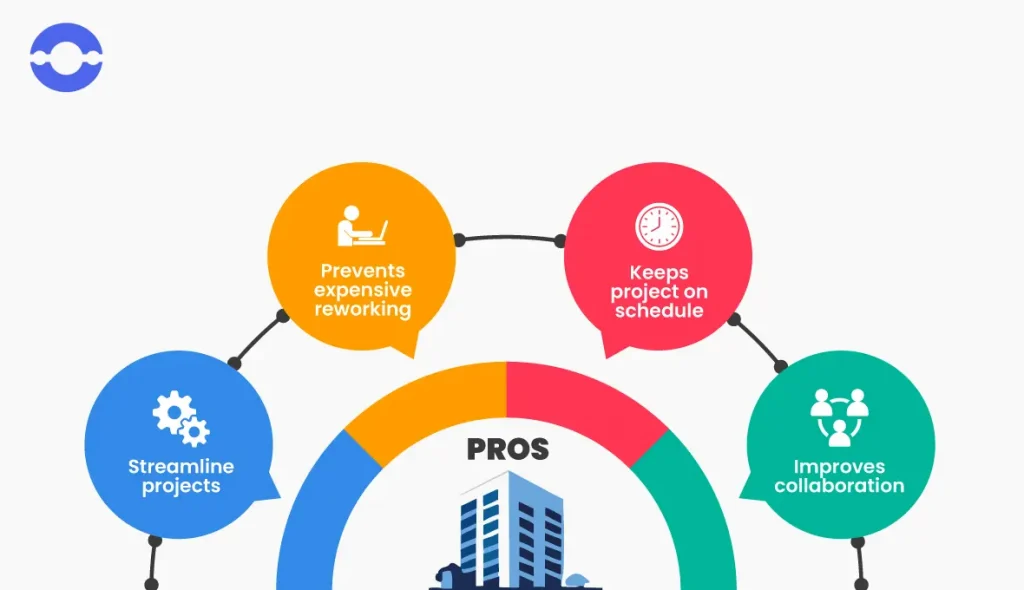
- Streamline Projects
AR and VR training solutions are capable of recreating real-life events in an immersive, risk-free environment enabling workers and staff to get a hint of the potential risks and dangers involved at the construction site. This is all done while keeping them out of any actual danger.
Simulations of heavy machinery created by AR can be used to test or evaluate a worker’s or team’s operational knowledge prior to interaction with the real machinery/equipment.
- Prevent Expensive Reworking
Construction industry commitments are time-bound due to massive budgets and the involvement of multiple teams. However, the work in this industry is also subject to a lot of rework, changes, and modifications by the clients because of the permanency of the product created.
While VR, 3D modeling, and BMI models help with changes and modifications, AR also helps with rework and cost minimization. The combination of AR and BMI allows construction plans to be adjusted and future logistics to be planned as desired.
AR also helps teams to identify potential overlaps, and risks, with VR enhancing worker and project safety and reducing the rework requirements due to accidents or mishaps.
- Keeps Projects on Schedule
With the help of AR and VR in construction, companies could present the 3D models and results to clients even before the work is completed. Any changes and modifications required, specifications and detail changes, etc., could be identified and made timely to avoid future delays, conflicts, and losses.
Paper schedules, gaps, and delays in communication could also be eliminated through AR overlays and faster identification of issues. Inspections in this case could also be conducted easily using AR and VR. Moreover, increased collaboration between teams and clients further enhances project management and teamwork and the quality of the product constructed.
- Improves team collaboration
The pandemic pushed for remote work. However, in an industry like construction, remote work can be a baffling situation and could result in poor communication, high risks, and accidents. This is when AR became prominent in the construction industry.
AR in construction streamlined collaboration in remote environments by allowing teams to share 3D images and videos with members who are not on-site. The same images could also be shared with the stakeholders.
The industry then, after realizing its many benefits, started employing the technology in other processes as well. And AR and VR technologies are never even disappointed. VR tools further ensure a more transparent project development process with greater collaboration and productivity resulting in more fruitful partnerships.
AR applications such as Assist AR or the use of xMake are leveraged to optimize collaboration between different individual parties/teams.
Also read: AR And VR Advantages And Disadvantages
Having noted down the use cases and benefits of AR and VR in the industry, let’s discuss the future of AR and VR in construction briefly in the next section of the blog.
Future of AR and VR in construction industry
The future of VR and AR in construction industry looks extremely promising due to the many benefits these technologies offer to the sector. The two emerging technologies are changing some of the fundamental operational ways and allowing the industry to embrace digitalization for its own good.
Currently, AR helps teams render models as well as structures in their precise location before they are even built. This helps in the identification of potential risks in advance.
But the future seems much more exciting for this technology, where it is being said that AR will be instrumental in the comparison of installations against specification models to accurately evaluate ongoing work, ensuring it stays within accepted tolerance levels and validates works in real-time.
Moreover, work is in progress for enabling construction companies to digitally remove as well as relocate structural components; thereby changing the plan of a structure easily on an AR-enabled tablet. This will allow engineers to troubleshoot any errors in a virtual view prior to applying changes to the physical structure.
The entirety of design and construction might also soon be managed completely from home. There have been steps taken in that direction. In an Owner-Architect-Contractor (OAC) meeting, for example, the contractor can provide the owner with a digital model of their building pre-, during, and post-construction.
Thus, the future holds many breakthroughs and innovations in AR and VR technologies in the construction industry.
Having said that, there are also some limitations of AR and VR in construction that have been identified by the industry and through some studies. These systems are viewed by many workers and heads as being too difficult to learn and understand and thus, demand extensive training by them.
However, industry specialists are optimistic that the future will witness enhanced AR integration courses and more individuals will join VDC (Virtual design and construction software).
Secondly, the “clunkiness” of AR goggles and the unstable/discontinuous internet connection that is sometimes shared between devices, is seen as a big problem in the adoption and application of AR and VR.
As a result, smaller, more transparent, and construction site-compatible personal protective equipment (PPE) goggles and other wearable devices have been recommended and the work is in progress for the same.
As for the internet connection, a major improvement is yet to be made, reducing or completely eliminating disconnections, and enhancing workability. More faster network connections such as the 5G might help the industry, more or less. overcome this limitation.
A survey and trend analysis of AR and VR adoption conducted in 2020 stated that “the AEC industry is far behind other industries such as healthcare and retail in adopting AR/VR technologies.”
However, with rapid improvements happening, the researchers from the same study also expressed their optimism for the future use of AR and VR in the construction industry and concluded that older generations in construction have great confidence in the future of AR and recognize the benefits of this technology.
As a result, the use of the technologies in the industry will witness “strong growth” in the next 5 to 10 years.
Also read: How Much Does It Cost to Develop an AR App?
Conclusion
The COVID-19 jolted the construction industry, like the rest of the world. However, AR and VR in construction, among other technologies, came to the rescue of the industry during the pandemic. In addition, they are capable of helping the sector weather the storm caused due to more such external shocks.
From allowing workers to train safely and efficiently, to eliminating errors and offering insights, AR and VR have enhanced the quality of project life cycles.
The relationships between multiple stakeholders and teams have also significantly improved because of these technologies; facilitating better communication and collaboration, two aspects that often trouble the industry and its working.
Thus, the past, present, and future of these two technologies have been and will be bright and exciting. The present use cases would be expanded and thus, the benefits would multiply too. The limitations are and will be tackled with rapid inventions and improvements.
Headsets and other AR/VR equipment are getting lighter and sturdier. AR/VR apps are becoming faster, more intuitive, and more effective. Thus, as these solutions continue to mature, the chances of their adoption in the construction industry also become higher.
Thus, we recommend you explore and invest in these technologies as soon as possible to adapt and enjoy the benefits arising out of them and their advanced versions.
From safe and effective training and eliminating on and off-site errors and accidents to gaining data-driven business insights, BigOh, a leading tech industry name, makes AR/VR apps that best suit the business requirements and propel growth!
Keeping business nature and needs in mind, our dedicated development team and other experts ideate and design the most practical solutions, test them thoroughly, and maintain them for long-time support.
We helped a client by developing an AR/VR app in Proptech that allows homeowners and renovators to connect on a single platform. This helped the homeowners to get an idea of how the space would look post-renovation and get a quote for the same.
If you want your business to also have reliable and scalable tech solutions to streamline, simplify, and optimize operations, then BigOh is the partner for you!
Get in touch with us today!




